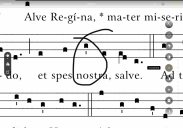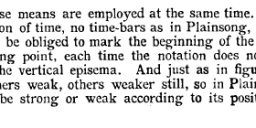What is this mark?
-
The little vertical thing- what does it do? Thanks.

 CC51A1EC-53AB-4346-829E-4240C551AC51.png2388 x 1668 - 4M
CC51A1EC-53AB-4346-829E-4240C551AC51.png2388 x 1668 - 4M -
Jani,
It's called an ictus, and it marks the beginning of a group of two or three notes.
What importance, beyond marking the group of two or three notes depends partly on who is answering the question.
Oversimplifying, chant is made up of neumes and the groupings of two/three notes. The ictus tells you something analogous to but different from what a bar line tells us in modern notation. -
Okay- so in other words....nothing to worry about, just sing. (?) Thanks much.Thanked by 1Jeffrey Quick
-
Some musical symbols (but not, that one, so far as I can tell) look like icti, but are, in fact, vertical episemae (I think that's the correct plural). Those have a different impact than a mere ictus.
But, I wouldn't worry about these marks, even if you became much more acquainted with the singing of chant.Thanked by 1Jani -
I agree, do not worry about these marks. They were introduced by some monks at Solesmes to support their theory of how chant should sound, but never universally agreed even by other singers at Solesmes. I have been singing chant since 1949 and have never understood the explanation, part of which I attach. (That comes from p.xxvij of the Liber Usualis in the 1961 copy downloaded from the Resources page of this CMAA website.)
Incidentally, the best opinion (mine) about the plural of ictus (which is short - ictŭs) is that it is ictus (long - ictūs).
The Solesmes marks are copyright, and do not appear in Vatican published official chant books. The official line is that they are tolerated rather than approved.

 zzsnap.png574 x 140 - 14K
zzsnap.png574 x 140 - 14K -
It's da dwed piwate woberts!!!!!
-
I don’t think so, Cantus....it doesn’t look a bit like Westley or Inigo. Or even Fezzik in a cape, for that matter!
-
Icti... another plural config... can be useful but also a distraction and even a conundrum... pick your flavor
-
It is sometimes called a vertical episema and does not appear in chant paleography. Therefore the best thing to do with it is is to ignore it. Counting groups of two and three neumes has long been discredited and has not been done at Solesmes itself for decades.
Fr Columba railed against so called icti and said he had never seen one.
Currently, the 'last word' on chant interpretation is Gregorian Semiology, by Dom Eugene Cardine, a Solesmes publication which may be had from GIA, Paraclete, and others. I recommend it highly to you. -
Tell Fr C that If he gets up early enough he can find them running through the forest behind the Solesmes monastery... Sometimes harmless, but they can bite. Stay far away from the the rabid variety.Thanked by 1ServiamScores
-
The ictus was a marking added by the Solesmes abbey as information for conductors; it was part of their interpretation system developed about 100 years ago; it was useful, and is still widely followed by many performers, but it is no longer considered to have a sound intellectual basis.
-
If you are pursuing archaeology, the ictus etc. does not measure up nowadays because scholarly taste has long since moved on. But as a very philosophically worked out system, to dismiss it by saying that it is not sufficiently historically pure is a bit like saying that this thing which is supposed to be triangle is not blue enough: there is something of a category mismatch.Thanked by 1Arthur Connick
-
I find it useful to observe the ictus, especially in melismatic passages. They help organize the accents.
-
And as a matter of (neuro? psycho? physio)-logical fact, it is almost impossible to hear or sing a sequence of equal beats without sensing twos and threes.
(This might mean that the ictus emerges directly from equalism...)Thanked by 1WGS -
I wish respectfully to disagree with Andrew on this point. It is possible, as happens often in chant (particularly in highly, or even moderately melismatc passages), to find groups of five, seven, four, eleven, six and more 'groups' in any chant I could think of. There may also be groups of two or three neumes, but they are far from universal, and certainly are not foundational. Counting and expecting groups of two or three is to shackle chant to a metronomical system which is foreign to it.Thanked by 1francis
-
Of course it's true that there are long melismata: always notated with multiple neumes in whatever period they were recorded. My point (and experience and conviction) is that such a string of notes can hardly fail to suggest twos or threes. That's not to say there's a unique right way to "count" them, still less that the "ictus" should be stressed!
No, all I mean is that ta ta ta ta ta ta ta, seven puncta in a row, are bound to feel like ta-ta ta-ta-ta ta-ta or ta-ta-ta ta-ta ta-ta or ta-ta ta-ta ta-ta-ta etc, depending on the shape and pitches of the phrase. Nothing to do with chant, just rhythm: except that (unless you interpret mensurally) the chant presents sequences of many notes of apparently equal length on the same syllable, rather often.
I must admit (and cannot defend on historical grounds at all) that I sing Gregorian with quite a lot of variation in the length of the punctum: light ones are faster, descending subpuncta are quite a bit faster: spondees (I mean one syllable to a punctum, which happens, surely for emphasis, in a number of communios and not a few graduales) are slower. And the "threes" might be a smidgen faster than the "twos" -- although not so that it's triplets and duplets.
Nothing metronomic here. -
My interpretation is similar to Andrew's—though I shun equalism, I find myself mentally grouping into twos and threes based on the neumes and melodic shape helps add rhythmic buoyancy and prevent the chant from being bogged down. I neither search for nor need specific historical data to feel comfortable in my approach, though.
-
PURPLE -...specific historical data,,,,
Surely; you meant not 'specific' historical data' but 'spurious' historical data?
Welcome to the MusicaSacra Forum!
To participate in the discussions on Catholic church music, sign in or register as a forum member, The forum is a project of the Church Music Association of America.
Categories
- All Discussions21,076
- General Music Discussion8,207
- Job Openings194
- Management of Music Programs850
- Choral Matters532
- Church Documents and Rubrics524
- CMAA Notes300
- Events713
- For Newcomers: Read First26
- Sacred Polyphony546
- Hymnody871
- Gregorian Chant: General2,694
- ↳ Graduale Romanum and Liber Usualis367
- ↳ Graduale Simplex60
- ↳ Semiology63
- Vernacular Plainsong696
- Anglican Use and Anglican Chant68
- Organ, Other Instruments and Repertoire434
- New Composition/Works in Progress1,288
- Recordings230
- Music for Hispanic Ministry159
- Music Education: Children211
- Music Education: General222
- News Items245
- Positions Wanted2
- General Discussion: Catholicism738
- Amusements176
- General Discussion1,033
- Opinions117



